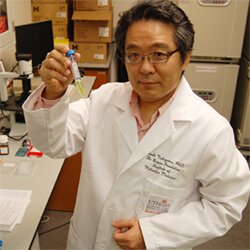Arthritis breakthrough could end agony for millions of sufferers
Arthritis breakthrough could end agony for millions of sufferers
MILLIONS of Britons could be spared the agony of crippling arthritis pain after a major breakthrough by scientists.
They have developed a pioneering simple new technique to generate cells which can go on to re-grow damaged cartilage and even bone. The process offers major hope for people suffering in daily pain from the degenerative joint condition. It paves the way for a quick treatment – possible as a single injection of the stem cells – directly into the effected joint to end the agony.
At least 8.5 million Britons suffer from osteoarthritis which is caused by wear and tear on joints where the cartilage that cushions movement is worn away. Bones then come into contact with each other and the friction makes joints swollen and extremely painful. Now, researchers from the University of Texas Health Science Centre in the US, have used a combination of small molecules to generate mouse cells that can form bone and cartilage. They say the new method could allow them to re-grow broken bones and mend cartilage damage to back discs and joints.
It would revolutionise treatment for the condition because it would not have the side effects of many of the current drug-based treatments for the condition. The research team, led by Dr Naoki Nakayama, created special stem cells known as pluripotent stem cells from mouse embryos. This type of stem cell has the ability to become any cell type in the body. The team then used small molecules to persuade them to turn into cells that can form cartilage, called chondrocytes.
Dr Nakayama, whose study is published in the journal Development, said: “Current cell generation strategies generally use proteins to direct the stem cells to give rise to functional cells of interest. “Such proteins act on the target cells through multiple mechanisms, not all of which necessarily help to achieve the overall goal of generating chondrocytes. “In addition, proteins are unstable and expensive to make, and the cost is one of the hurdles that limits the ability of scientists to make the amounts necessary for clinical purposes. “In contrast, small molecules are generally longer-lasting than proteins in culture and also inexpensive to produce to a large scale. They can also allow a particular mechanism to be more precisely activated.”
Using embryonic stem cells and small molecules, the team was able to generate cells that look and behave like chondrocyte precursor cells that are destined to form cartilage for the formation of backbone and disc. When such cartilage was transplanted into mice, they were able to form bone-like structures.
Dr Nakayam said the team’s strategy offers great potential in the repair of bone defects through cartilage or potentially of damaged cartilage itself in humans in the future. This is because the technique can easily be scaled up to produce large numbers of cartilage-forming chondrocytes.
Stephen Simpson, director of research at charity Arthritis Research UK said: “Stem cells act as the body’s repair kit, because they have the unique ability to become many different types of cell in the body. “This means they have great potential for use in repairing damaged cartilage in the millions of people living with the pain of arthritis on a daily basis. “This is an interesting study with promising results, shedding light on ways that stem cells can be encouraged to develop into cartilage cells. However, further research will be required before we can know whether this specific approach will be suitable for repairing human bone and cartilage damage. “Arthritis Research UK have invested in a tissue engineering centre, which aims to identify the best kind of stem cell for cartilage repair that could contribute towards preventing or easing symptoms in those with early osteoarthritis.”
Each year, the NHS carries out more than 140,000 hip and knee replacements at a cost of more than £1billion. So a new treatment for osteoarthritis would save the NHS a fortune. Current treatments can only relieve the painful symptoms of the disease. One drug was recently approved for use in Britain which can dramatically slow its progress but it is still incurable and often leads to costly knee replacements. Some patients even have to undergo two joint replacement operations because artificial hips or knee joints can wear out after just 15 years.
source: http://www.express.co.uk/life-style/health/519927/Arthritis-breakthrough-end-pain-for-sufferers
Pin It


